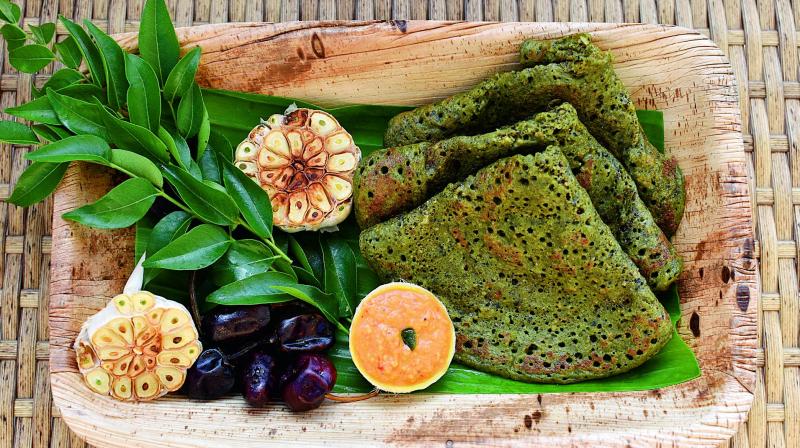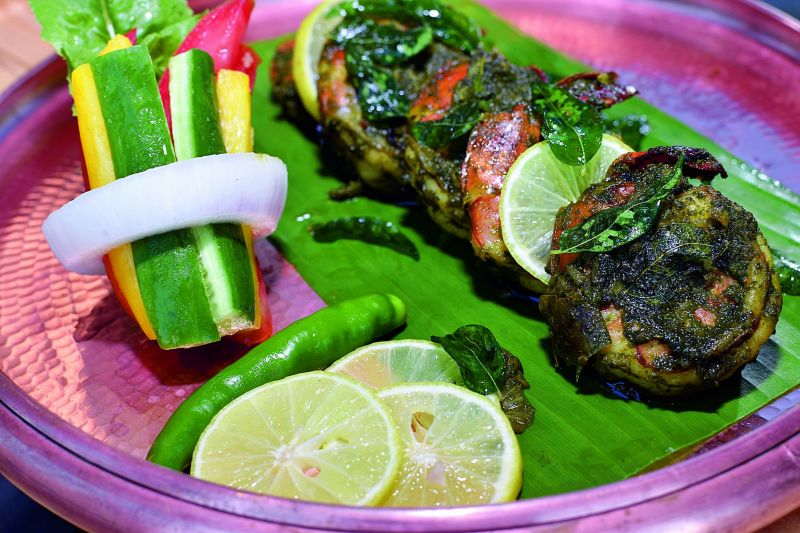Currying FAVOUR
The cornerstone of South Indian cooking is the curry leaf. here's how to use it in innovative and delicious recipes.

Unlike North India which relies heavily on mint leaves most Southern recipes from Tamil Nadu or Karnataka are incomplete without the potent curry leaves. Strangely enough the leaf it its full form isn’t consumed but used to lend a powerful, pungent flavour to the recipe.
In Indian folklore there is a saying that likens a person to a curry leaf stating that he is discarded after his particular use just like a curry leaf!
ALL ABOUT THE CURRY LEAF
Curry leaves either grow in a shortish shrub around three feet or else a huge tree that rises to almost two feet in height. It grows only in India and neighbouring Sri Lanka. Most housewives grow a small plant at home and pluck a few leaves for daily cooking. The taste is bitter and pungent and the dark green almond-shaped leaf has a pungent aroma. Its versatility is such that both seafood and vegetarian dishes can be spiced up just as well using curry leaves. In South Indian food its use is far reaching and used to flavour meats, vegetables, lentils and fish. The leaves when ground with coconut make daily chutney served at meal times everywhere one goes. The leaves are dipped in hot oil either to scent it or as part of a tadka.
SELECTION AND STORAGE
Buy fresh bright coloured stalks that are unbruised and have springy stalks. Dried leaves are greyish-green and brittle.
According to Chef Mukesh Sharma, Executive Chef, Sheraton Grand Chennai Resort and Spa, “Select the baby curry leaves where you can, as I find they give good taste and colour to the dish. When making a dry curry leaves powder, make sure the leaves are completely dried up.”
A great way to preserve the leaf is to dry it, crush it and mix it with spices (karuveppillai podi).
NUTRITIONAL AND HEALTH BENEFITS
Being frequently used in the Indian kitchens, curry leaves or kadipatta as it is popularly known, have boundless health and beauty advantages on offer thanks to their vital nutrient content.
“They encompass various antioxidants that functionally combat the cell-damaging free radicals in the body, thus safeguarding the body from any health snags. Curry leaves come packed with carbazole alkaloids, compounds that have antioxidant, anti-bacterial and anti-inflammatory properties,” says Dr Siddhant Bhargava, Co-founder, Fitness & Nutritional Scientist — FOOD DARZEE.
They play a vital role in quickly healing swelling, itchy skin, injuries and burns due to their alkaloid content.
Consuming this high-in-nutrition edible, aids in the weight reduction process, munching on them majorly condenses unwanted fats from the body. Curry leaves comprise of minerals like iron and zinc which act as sugar lowering agents, thus they are a boon for diabetics. The presence of vitamin A in them is extremely good for improving eyesight. Lastly, they are a great option for repairing hair and scalp damage and enhance the consistency of your rough and damaged hair.
Ingredients
500 gm green millet
100 gm par boiled rice
100 gm white urad dal
15 gm fenugreek seeds
35 gm salt
150 gm jaggrey
5 ml ghee
100 ml water
100 gm curry leaves
Please note: Millet and rice, dal and fenugreek must be soaked together for nearly five hours and washed three or four times.
Method:
Drain the water and grind the mixture by adding water. Once the batter is ground to a favourable consistency (i.e. fine paste) take out the batter and mix the salt and jaggery. Then clean the hot plate and pour the batter cook it till the desired golden colour is achieved. Take out from hot plate fold nicely and serve hot with Mango chutney
Karuveppillai podi
Ingredients
(for one portions)
100 gm white urad dal
50 gm toor dal
80 gm bengal gram lentil
50 gm masoor dal
25 gm par boiled rice
10 gm dry red chili
100 gm curry leaves
10 gm asafoetida
20 gm salt
25 gm white
sesame seeds
10 gm black
peppercorn
Method:
Mix all the lentils, with chilly in the pan and dry roast till the dal turns golden colour, remove in a plate add asafoetida, curry leaves and salt. In the same pan dry roast par boiled rice and sesame seeds separately. Mix all together and cool down. When it completely cools down, make a slightly coarse powder. The powder is served with melted ghee and gingerly oil.
Karuveppillai Prawn
Ingredients
(for one portions)
600 gm cleaned prawn cleaned
25 gm green chilly paste
30 gm ginger paste
60 gm garlic paste
50 gm coriander leaves, chopped
30 gm onion
50 gm curry leaves, fried and crushed
5 gm idly podi
20 gm salt
20 ml oil
1 lemon
Method:
Marinate the prawn with ginger garlic paste and salt. Deep fry the curry leaves and crushed it separately and heat oil in a pan add chopped onion and curry leaves and green chilly add marinated prawns and stir fired with salt and add crushed curry leaves.
Finely sprinkle little crushed curry leaves and idly podi, chopped coriander leaves, lemon juice and serve hot.


